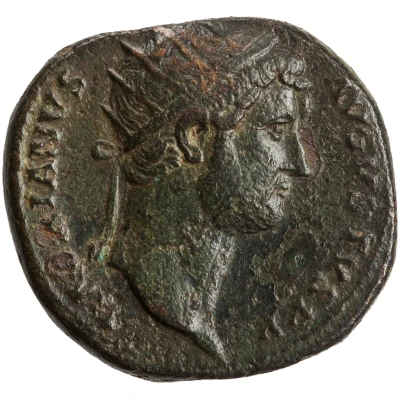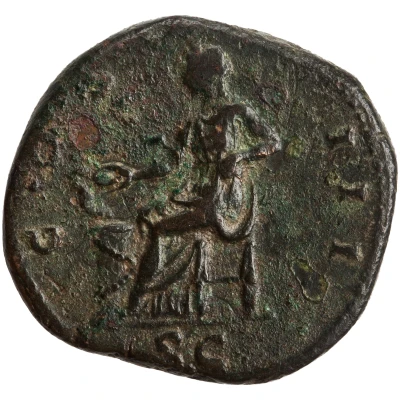


© American Numismatic Society (ANS)
Dupondius - Hadrian COS III S C; Salus
| Orichalcum | 12.5 g | 27 mm |
| Issuer | Rome › Roman Empire (27 BC - 395 AD) |
|---|---|
| Emperor | Hadrian (Publius Aelius Hadrianus) (117-138) |
| Type | Standard circulation coin |
| Years | 128-129 |
| Value | 1 Dupondius = ⅛ Denarius |
| Currency | Denarius, Reform of Augustus (27 BC – AD 215) |
| Composition | Orichalcum |
| Weight | 12.5 g |
| Diameter | 27 mm |
| Shape | Round (irregular) |
| Technique | Hammered |
| Demonetized | Yes |
| Updated | 2024-10-06 |
| Numista | N#255479 |
|---|---|
| Rarity index | 100% |
Reverse
Salus seated left, holding out patera to feed snake; to left, altar with snake coiled around.
Script: Latin
Lettering:
COS III
S C
Translation:
Consul Tertium. Senatus Consultum.
Consul for the third time. Decree of the senate.
Comment
Source: Online Coins of the Roman Empire (OCRE)Interesting fact
The Dupondius coin featuring Emperor Hadrian (COS III S C; Salus) from the Roman Empire (27 BC - 395 AD) made of Orichalcum is interesting because it showcases the advanced metallurgical skills of the ancient Romans. Orichalcum, also known as "golden bronze," was a prized alloy of copper, zinc, and sometimes small amounts of gold or silver. It was highly valued for its durability, corrosion resistance, and golden-like appearance, making it an ideal material for coins and other luxury items. The fact that this coin was made using Orichalcum speaks to the Roman Empire's advanced metalworking techniques and their ability to produce high-quality currency.